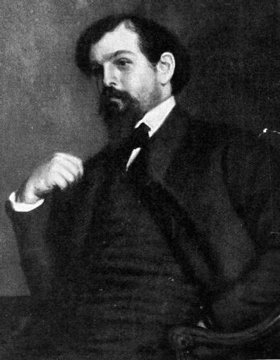Claude Debussy – man of great flute and piano duets
How to record piano and flute in a classical context
Recently, I had the opportunity to record a flute and piano duet. This was my first foray into recording true classical music, and I would like to share my experiences.
For this session, the two performers were playing live in the same room. While I have experience recording pianos, I have never worked with a flute. There was definitely some trial and error in finding the proper mic placement for this instrument. Trying to get a healthy balance between the airiness and body of the flute proved to be quite a challenge. After going through various flute mic’ing techniques, I ended up with the microphone (Neumann u87) elevated two feet or so behind the performer, aiming at the center of the instrument. To me, this seemed to sound the most natural.
There are so many piano recording techniques. Since this session did not allow for extra time to experiment with the subtleties of various microphone placements, I went with something that was familiar. For the baby grand piano, I choose to use a 90 degree near coincident stereo pair (NOS) up top and a large diaphragm condenser under the piano, as close to the soundboard as possible. The result is a full and balanced piano sound. The under mic picks up a lot of sustain and adds more low end to the stereo pair. I used Neumann km-54s as the NOS stereo pair and a Neumann u87 underneath.
Signal Chain:
Flute –> u87 –> Hardy M1 –> ProTools
Piano (top) –> km-54 NOS stereo pair –> Trident 80B channels –> ProTools
Piano (bottom) –> u87 –> Hardy M1 –> ProTools
Overall, I would say I am very satisfied with the way things turned out. I think for the type of music being recorded, the final sound is fitting. The mic choices and placements seem to work well in a classical context. Since both performers were in the same room, there was a bit of instrument bleed in each microphone. In the setting of these live recordings, this actually turned out in a favorable mannor. Having the two instruments together helped add a bit of natural reverb and also gave each instrument a place in the room. After doing more research, I think I would like to try a ribbon mic on flute the next time I have the chance to work with one.
Out of the three pieces recorded, one was solo flute, one was a flute/piano duet, and the last was a duet for piano and bass flute. I used the same flute mic’ing technique outlined above on the bass flute. This was my first time ever hearing one of these – what a cool instrument! As far as I know, the bass flute is the same as a regular flute but scaled down one octave.
Here is an excerpt of one of the pieces – this one features the bass flute.
Bass Flute and Piano Duet


The sample sounds very bad, the music and the recording!